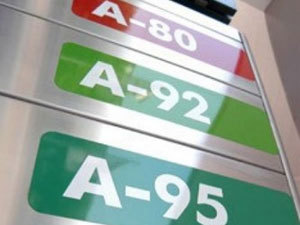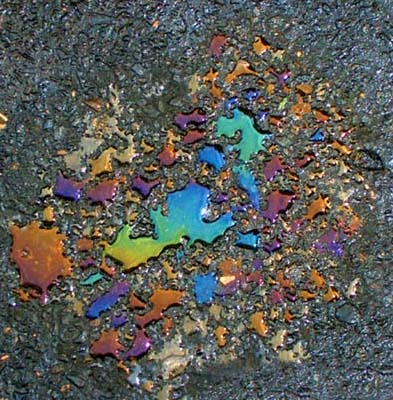
Octane number
Octane number and cetane number. The petrol and diesel fuel has opposite requirements, because of fundamentally differents devices motors Daimler and Diesel.
In the internal combustion engine with forced ignition of the mixture of petrol and air in the cylinder during compression should not catch on fire by itself. If this happens, there is detonation.
For the first time the resistance of petrol to detonation was investigated in 1921, an American engineer, Ricardo. He proposed the first scale knock resistance of gasoline. In the early 30's, due to high resistance to detonation for the standard was selected isooctane (2,2,4-trimethylpentane). It was mixed in various proportions with normal heptane structure (he is very prone to detonation), and each sample was determined detonation resistance. Octane number in this grade pertrol is numerically equal to the content (volume %) of isooctane in its mixture with heptane, in which this mixture is equivalent for detonation resistance of the investigated fuels standard test conditions. Octane number can be higher than 100 % (if gasoline is more resistant to detonation than pure isooctane).
*Detonation is an explosive ignition of the fuel, which manifests itself in the form of the characteristic sound and leads to rapid engine wear. Upon detonation flame front propagates with the speed of 2-2,5 km/s, whereas in the normal combustion in the cylinder speed is only 15-60 m/S.
For the petrol is important that it did not ignite when mixed with air, even at high compression ratio, diesel fuel, on the contrary, it is necessary that it spontaneously ignited in the cylinder. To characterize the ability of different grades of diesel fuel to the fire, is used cetane number. It is defined by comparing the ability to ignite the fuel and mixture of hydrocarbons cetane (hexadecane C16H34 boil. t=287 °C) methylnaphthalene (liquid with boil. t=245 °C)
The octane number of petrols
- Petrol direct race 40-70
- Petrol thermal cracking 70-75
- The catalytic cracking petrol 80-90
Cetane number corresponds to the percentage of cetane in a mixture: the higher it is, the easier the fuel ignites under compression. The more fuel unbranched saturated hydrocarbons and less branched and aromatic, the greater the ability to auto-ignition and detonation. Car hire is charged with a mixture of petrol fractions isolated in different processes of oil refining. The basic components of petrol, in addition to gasoline direct distillation, is a fraction obtained by catalytic and thermal cracking and reforming. The octane number of these fractions, as a rule, do not exceed 90. Therefore, in the composition of petrol also include high-octane components, which are used in special industrial reactions.
The lengthening of the hydrocarbon chain can increase the octane rating up to 105. The mixture of all these components allows you to get petrol with the necessary octane number.
Composition of petrol
Petrol. Composition of petrol
The problem of increasing octane number of petrol can be solved with special additives (called anti-knock additives). Thus, the addition of 0.82 g of tetraethyl lead Pb(C2H5)4 to 1 kg of isooctane increases the octane number to 110. A huge disadvantage of this additive (ethyl fluid) is that when combustion are formed of highly toxic lead compounds, most of which with the exhaust gases emitted into the atmosphere. Because of this, in many countries it is forbidden to apply tetraethyl lead.
Now the main additives that increase octane number, are oxygen-containing compounds, ethyl alcohol, tert-butyl alcohol (CH3)3СОН, methyl tert - butyl ether (CH3)3COCH3, tert-amyl ether2H5(CH3)2CH3. The octane number of these compounds are high (e.g., (CH3)3COCH3 is 120), and their toxicity, and their products of combustion (water and carbon dioxide) is low.
High-quality petrol

High-quality petrol In addition to octane number of petrol, which should correspond to the class of engine, fuel is presented several important requirements. First and foremost is its fractional composition content in petrol separate fractions with different boiling points. The starting the engine, the warm-up duration, completeness of combustion of fuel are dependent on the conditions of fractions.
When the industrial production of petrol in them dissolve gaseous linear and branched butane, which not only have high octane numbers but are characterized by high vapor pressure.
Another requirement is chemical stability. To increase stability in petrol during storage add a special antioxidant substances. Their action is based on the slow process of oxidation due to the transformation of active radicals to inactive. With the disengagement of the active moiety of a hydrogen atom from the OH- group is formed inactive radical, terminating the chain reaction of oxidation.
Compare expensive perfume with their complex unique flavor and is characterized by smelling yellowish oil liquid, is poured into the fuel tanks of cars at gas stations. At first glance it may seem that perfume masterpiece is painstakingly filigree work, and petrol is just the product of large-scale chemical production. In fact, on the complexity of the composition of ordinary petrol can compete with good perfume, and with requirements of modern society for quality, efficiency, environmental friendliness petrol, stimulate the hundreds of chemical laboratories around the world. These giants of the world petrochemical industry "British petroleum, shell, Chevron - annually spend millions dollars on developing the most advanced, environmentally friendly anti-knock additives, searching for new and unique compositions of fuel. And because that one day, when the oil reserves of the Earth will come to an end chemists have fantastic and complexity task is how to wisely spend what we have, and find that it can be replaced.
Ethyl fluid is a solution of tetraethyl lead in ethylbromide C2H5Br. When it is burned, the lead goes into volatile bromide PbВr2 (t melt.=370 °C, boil. t=893 °C).
To determine whether there is in petrol tetraethyl lead, use qualitative reaction of Kimshtedt. A few drops of gasoline put on filter paper and dried. When it is handled by hydrogen sulfide or ammonium sulfide is formed of lead sulfide, and you can see intense dark colour on filter paper.